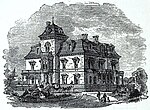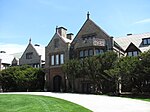Rovensky Park
1959 establishments in Rhode IslandGeography of Newport, Rhode IslandParks in Rhode IslandProtected areas of Newport County, Rhode IslandTourist attractions in Newport, Rhode Island

Rovensky Park is a historic park at the corner of Bellevue Avenue and Rovensky Avenue (previously Wheaton Street) in Newport, Rhode Island, USA. The park grounds were created in 1852, and the park was purchased by the Preservation Society of Newport County in 1959 with $175,000 grant donated by John E. Rovensky in memory of his wife, Mae Cadwell Rovensky. The Rovensky's former house, Clarendon Court, is directly across the street from the park. The park is still owned and maintained by the Preservation Society of Newport County.
Excerpt from the Wikipedia article Rovensky Park (License: CC BY-SA 3.0, Authors, Images).Rovensky Park
Rovensky Avenue, Newport
Geographical coordinates (GPS) Address Nearby Places Show on map
Geographical coordinates (GPS)
| Latitude | Longitude |
|---|---|
| N 41.46008 ° | E -71.30734 ° |
Address
Rovensky Avenue 35
02840 Newport
Rhode Island, United States
Open on Google Maps










